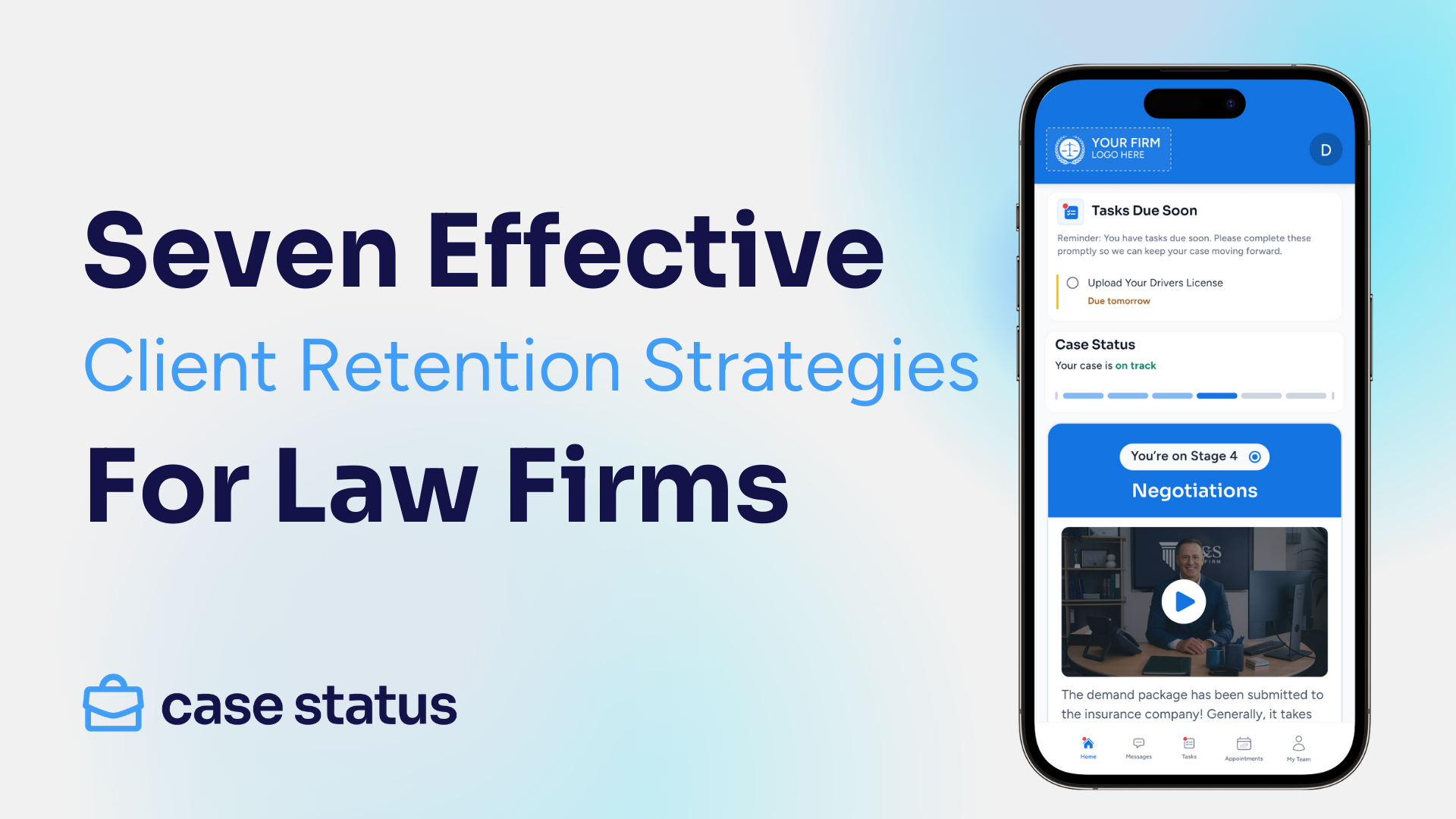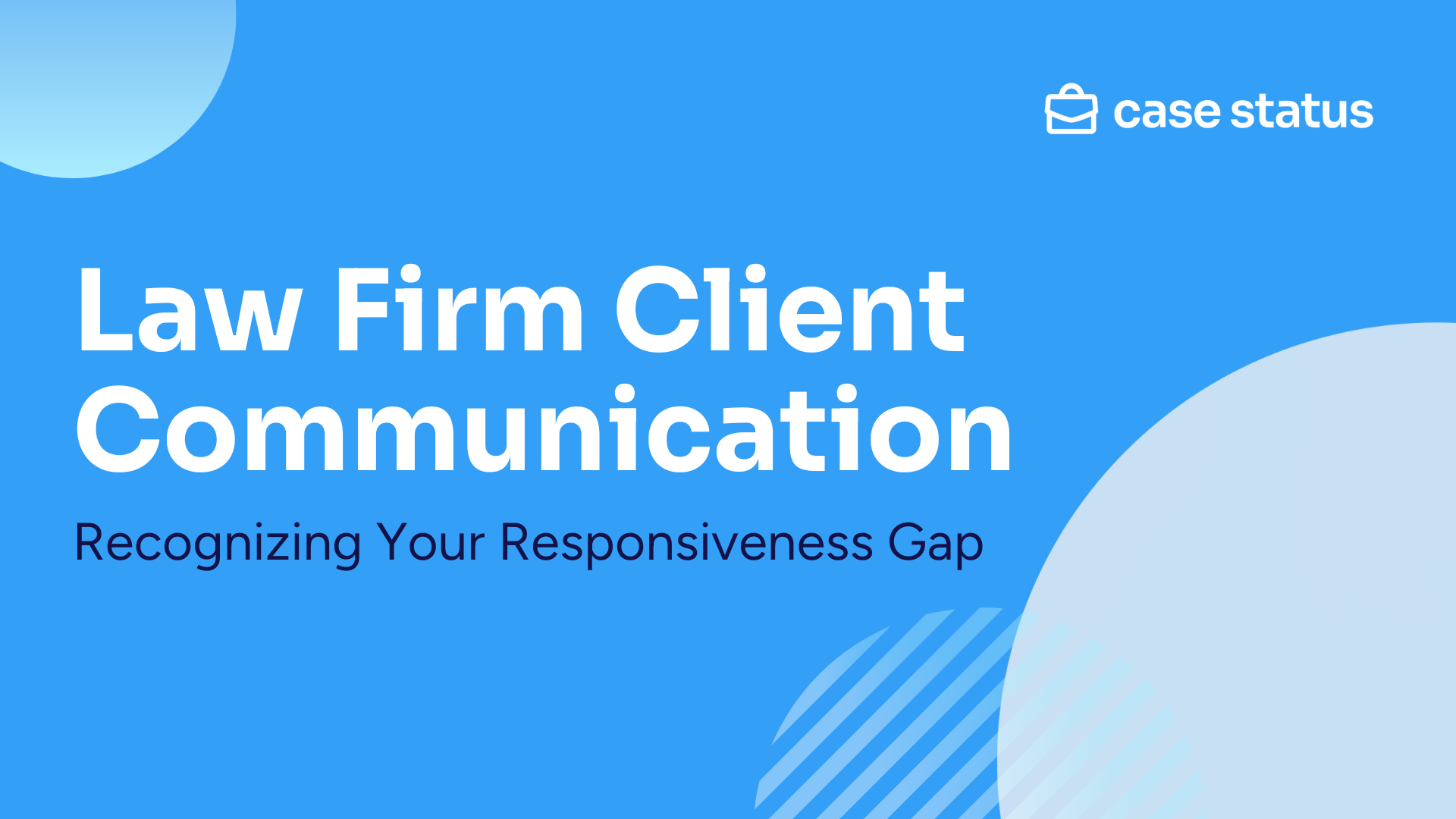
The legal industry has become increasingly competitive, meaning law firm client experience optimization is no longer a nice-to-have. It’s essential to your firm’s sustained, long-term growth. From initial intake to case conclusion, every interaction a client has with your firm shapes their perception of your practice.
If your firm isn’t delivering an exceptional client experience, it’s missing out on opportunities for firm growth and increased revenue. Improving the client experience has the potential to reduce time-wasting and reactive communication, enhance productivity, and foster better engagement.
While many firms already strive to deliver an excellent experience for clients, many fail to understand what those clients actually expect.
By meeting those expectations and implementing technology-driven solutions, your firm can create a competitive advantage for itself while delivering a better experience for both your clients and your team.
What Is the Value of a Good Client Experience?
Client experience is key to driving growth at your law firm and giving you an advantage over the competition. Clients have more choices than ever before, which often makes the quality of their experience more important than traditional factors, such as price or location.
For your firm, good client experience means growth and revenue opportunities. When clients have a positive experience with your law firm, they’re much more likely to return in the future with other legal needs. They’re also much more likely to refer your firm to friends and family and to provide a positive online review.
These personal recommendations carry a lot more weight than traditional marketing methods and can propel your firm’s growth.
Meeting Client Expectations
In a crowded market, creating a great client experience isn’t optional. It’s becoming a baseline expectation for many legal clients. However, many firms still fail to understand what their clients expect and how they may be falling short of meeting those expectations.
One of the biggest issues facing law firms is poor communication, which is the No. 1 Bar complaint in the legal industry. Clients expect on-demand access to information about their cases, yet most firms still rely on phone calls, emails, and in-person meetings to keep clients up to date.
Improving communication doesn’t have to be difficult. When technology-driven solutions are offered, clients are often quick to adopt them.
For example, according to the Case Status’ 2025 State of Legal Client Experience Report, self-service mobile apps have an adoption rate of 80% when they’re offered, which can transform the client experience while saving firms an average of 1,300 hours per year. Despite this easily achievable advantage, a mere 9% of law firms offer such apps to their clients.
How to Measure & Improve Client Experience in Your Law Firm
Improving the client experience begins with measuring your clients’ feelings toward your firm. By tracking client feedback, you’ll have a foundation for building an enhanced client experience that can drive growth.
Implementing a Client Feedback System
Two of the best tools for collecting and understanding client feedback are:
- Net Promoter Score (NPS): Based on how likely clients are to recommend your firm to friends or colleagues, and categorizes clients into detractors, passives, and promoters.
- Customer satisfaction (CSAT) scores: Tracks satisfaction with specific factors, such as communicativeness or onboarding, which gives you detailed insights into specific steps that may need improvement.
Automation is key to understanding and using your NPS and CSAT scores to build a more robust and positive client experience. With predictive NPS, for example, firms can use AI to predict when client relationships may be at risk of deteriorating and translate satisfied customers into promoters.
Similarly, automation allows you to collect feedback at important milestones, such as case settlements, so you can identify when your clients are happiest and when you may need to implement changes.
With this sort of automation, you’re able to take action sooner and resolve minor issues before they become major ones. This proactive approach to client satisfaction helps build loyalty and turns clients who are passives or even detractors into promoters of your firm.
Turning Feedback Into Results
Collecting data on client satisfaction is only one step to improving the client experience. To truly drive your firm’s growth, you need to translate these insights into actual change.
For example, delays and inconsistent communication are leading causes of poor client satisfaction. By learning how to build workflows to automate daily grunt work, you can free up your team to focus on delivering high-value work and consistent client communication.
Similarly, if your feedback data highlights issues with your onboarding process, you can develop a law firm client onboarding checklist. With a checklist on hand for each new client, the onboarding process becomes more efficient, consistent, and positive, which creates a highly valuable first impression that can generate referrals and positive reviews in the future.
You can also use feedback info to identify satisfied clients and turn them into promoters of your firm. For example, automated review collection can be utilized to encourage happy clients to leave positive reviews online, which can be a major driver for attracting new business.
For more actionable strategies, explore how to build a law firm CX playbook to make your firm more focused on the client experience.
How Technology Can Improve Client Experiences
Our research shows that only 40% of clients describe their firm as “caring,” despite 72% of attorneys describing their own firms as such.
This disconnect creates a perception gap between firms and clients, which is often exacerbated by reliance on outdated communication methods that fail to meet client expectations.
Why Traditional Communication Falls Short
Outdated communication methods, such as phone and email, create bottlenecks and lead to deteriorating client satisfaction.
Despite this, 86% of attorneys still handle client updates via phone calls or emails on a daily basis. This not only eats into attorneys’ valuable time but is also more likely to leave clients frustrated and in the dark about their cases.
Even worse, a mere 35% of firms are even tracking their response times, leaving most firms unable to identify and fix communication problems. Again, if firms aren’t aware of communication bottlenecks, clients are more likely to feel ignored and uncared for.
Traditional methods of communication are highly inefficient. Phone calls consume significant time, and emails are often lost in overflowing inboxes. The result is that clients often feel like they’re not being kept properly informed about their case, while firms become less efficient.
Using Legal Technology to Improve Client Communication
Law firms can learn how to improve the client experience with legal technology and AI. For example, using a secure online portal allows firms and clients to centralize information and communications.
So, instead of waiting days or weeks for a return call, clients can log into their online portal to check their case status, review documents, and receive automated updates.
This self-service model ensures client expectations are met by giving them 24/7 access to case information. It also addresses the cost of neglecting client engagement technology, top of which is lost staff time and stalled growth.
With a self-service platform, attorneys are free to focus on more high-value work rather than on time-consuming client communications.
Embracing AI for Client Satisfaction
The best law firm software today incorporates AI, so your firm can achieve even greater levels of efficiency while also dramatically improving the client experience. While many firms have already applied AI to routine administrative tasks, many are failing to use it to its full potential to improve client engagement and satisfaction.
For example, Case Status Client Intelligence™ can categorize client messages by order of priority, from critical to low priority. This allows staff to prioritize the messages that matter most while avoiding inbox overwhelm and delays.
Similarly, AI can learn your firm’s tone and language and draft responses that are tailored to each client’s message and needs. Also, with one click, Case Status generates summaries of case history, client sentiment, blockers, and next steps—so any team member can step in confidently, improving efficiency, continuity, and case resolution time.
This AI-driven approach ensures clients receive prompt communication that is personalized to them and frees up staff time to focus on other tasks.
Transform Client Experience Through Strategic Technology Adoption
Optimizing the client experience directly impacts almost every metric that affects growth and competitiveness: referral rates, client retention, revenue growth, and team satisfaction.
When firms invest in client experience technology, they see measurable improvements in client satisfaction, workplace efficiency, and business growth.
Adopting new technology requires commitment, but the process doesn’t have to be difficult. By starting with a systematic approach to measurement, you’ll have a better understanding of your current client satisfaction rates and you’ll feel empowered to tackle areas that need improvement.
With these insights, you can integrate AI and technology solutions that align with client expectations, while also freeing up your team to focus on more impactful work.
In an increasingly competitive industry, being able to improve efficiency while delivering a more tailored client experience will help your firm stand out.
Ready to close the gap and deliver an exceptional client experience? Book a Case Status demo to learn how implementing AI-driven legal technology can transform your client experience and increase revenue.



